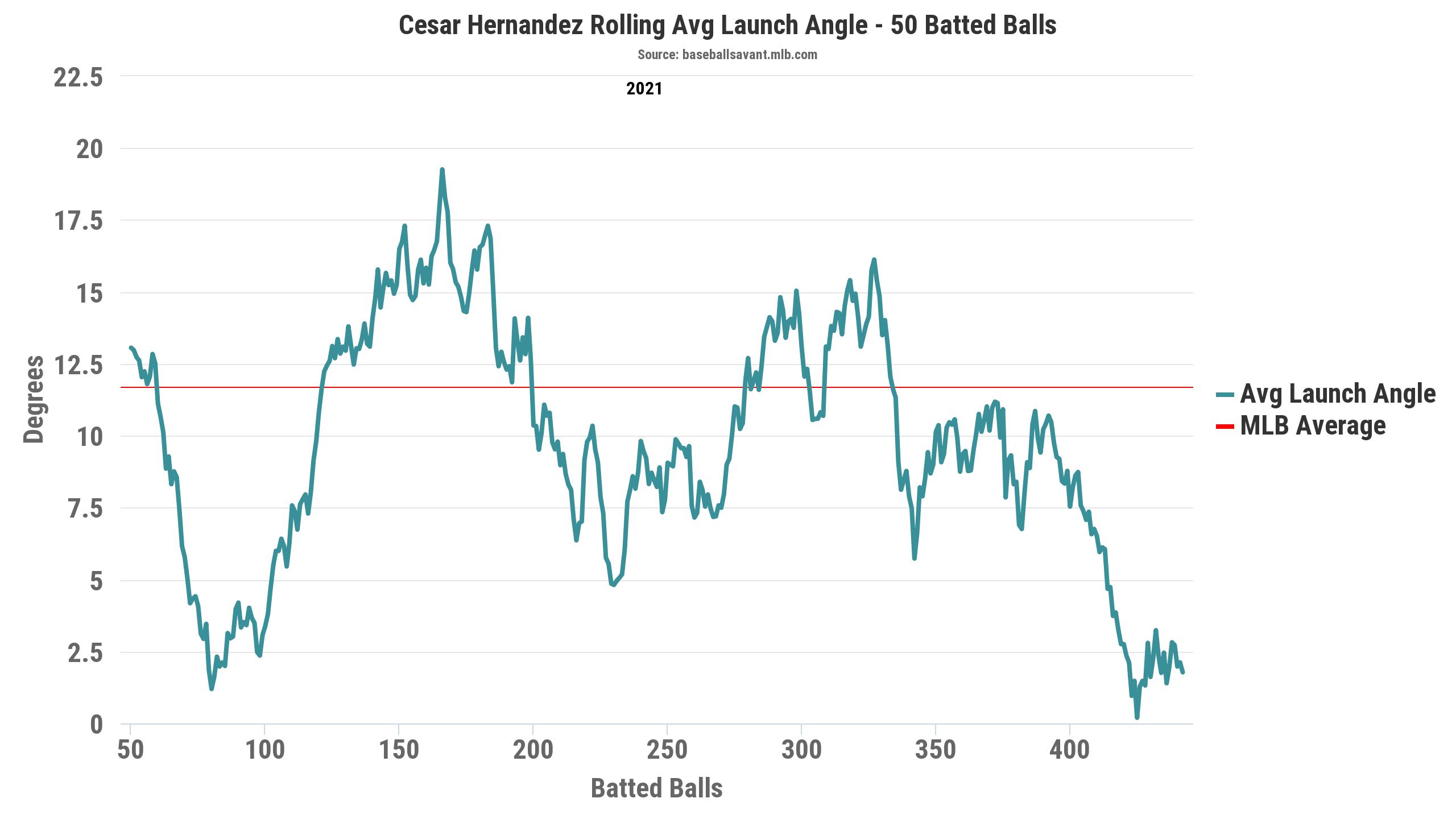César Hernández had one of his least productive and most productive seasons in the same year.
That reads like a misprint, and I’m just as confused by it as you might be. But that’s what happens when you have a player who spent the first 96 games of the season posting a career low batting average while boasting out-of-character power numbers. Hernández didn’t hit frequently while in Cleveland, but also topped his single-season career high in home runs by July 21.
Yet after being dealt to the White Sox at the trade deadline, Hernández’s power vanished. It was as if someone kicked a plug out of its socket. He gave Chicago just seven extra base hits in 217 plate appearances, enduring struggles that appear to be based on a sudden inability to read pitches he was tuning up in Cleveland.
Hernández has never been much of a slugger, having spent the bulk of his career with isolated power numbers coming in well below league average. Of the 873 hits he tallied during the first eight years of his career, only 24% went for extra bases.
Which made the first half of last season all the more bizarre. Though his batting average (.231) and OBP (.307) with the Guardians were uninspiring, his .199 ISO was 32 points above league average and 45 points higher than his previous career high. Hernández wasn’t making a ton of contact, but when he did, the offensive value behind it was far beyond what’s expected of him.
Want even more confusion? Just take a look at his righty-lefty splits. While Hernández did just OK against right-handed pitching, his performance against southpaws looks like a glitch in the matrix.
| Splits | Plate Appearances | Batting Average | BABIP | ISO | wOBA | wRC+ |
| vs. RHP | 274 | .239 | .287 | .150 | .302 | 90 |
| vs. LHP | 146 | .217 | .191 | .295 | .347 | 120 |
Hernández’s numbers in Cleveland hardly made sense, but they helped persuade the White Sox into exchanging one of their top prospects in pitcher Konnor Pilkington for his services at the deadline.
One would assume there’s some lingering buyer’s remorse in Chicago.
Hernández moved five hours west, but apparently forgot to pack his newfound power. His slugging percentage dropped 31%, while his ISO fell by 132 points. Against southpaws, Hernández’s ISO plummeted from .295 to a paltry .035.
What happened? Sure, Hernández has never been expected to hit for power. But a drop-off this steep is still pretty jarring, as is the notable decline seen in his quality of contact.

Data and graphic from Statcast

Data and graphic provided by Statcast
Likewise, though Hernández’s fly-ball rate dropped less than 1% with the White Sox, the gap between that and his HR/FB rate widened the second he stepped foot in the South Side.

Data and graphic from FanGraphs
There isn’t much to take away from how pitchers approached him in Chicago. Right-handers kept their pitch locations relatively similar to what Hernández was seeing in Cleveland. While there was noticeable variance in the way lefties pitched against him, the sample size is too small to garner much insight.
All in all, it seemed like Hernández’s biggest issue was a setback in the time it took to detect pitches he had been hitting well with the Guardians.
Here’s a sample of two four-seam fastballs Hernández faced middle up in the strike zone, one in Cleveland and one for Chicago. The first is a 93.8 mph offering he deposited 407 feet over the fence in dead center, the other a 91.4 mph four-seamer softly topped back to the pitcher.
Next is a look at how Hernández fared against two fastballs middle down. The first – a 92 mph four-seamer – was pulled off the top of the left field wall. The second – a 94 mph sinker – was sent screaming into the dirt three feet in front of him.
The swings look identical at first glance, but the key difference with each example is where the ball is the moment Hernández’s hands start moving forward. With the Cleveland samples, he’s starting his swing well enough in advance to induce top-shelf contact. In Chicago, his hands are notably later, resulting in a far less impressive batted ball.
The below snapshots provide the best view of this, along with proof it was occurring on both sides of the plate. The right-handed at bats are from the two previous clips, while he’s facing two separate 91 mph four-seamers right down the pipe in the screen grabs from the left side of the plate.
For a brief stretch of the 2021 season, Hernández was reading pitches well enough to put a jolt into them at a frequency we haven’t seen from him before. One clubhouse change later, he was just slow enough on his swing to make that power cameo come to a halt.
Perhaps Hernández was struggling to adapt to the first midseason trade of his nine-year career. Joining a team that, at the time, had deep playoff aspirations surely added a little more pressure to that situation.
Either way, Hernández was unable to replicate his surge in Chicago. While there remains a chance he can find it again with Washington this summer, nothing in his career numbers indicates this was anything more than a one-power-hit wonder.
Photo by Erik Drost/Flickr | Adapted by Doug Carlin (@Bdougals on Twitter)
